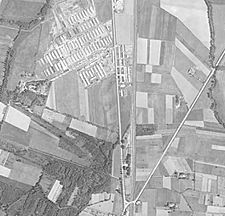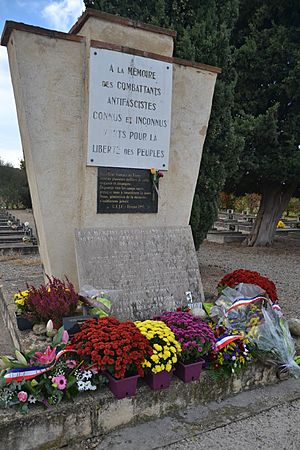Camp Vernet facts for kids
Quick facts for kids Camp Vernet |
|
|---|---|
| Transit camp | |

Aerial photograph (1945)
|
|
| Coordinates | 43°11′43″N 1°36′30″E / 43.19528°N 1.60833°E |
| Location | Le Vernet, Occitania Vichy France |
| Operated by | |
| Original use | Troop camp |
| First built | 1918 |
| Operational | to June 1944 |
| Inmates | Spanish refugees, Jews, former members of the International Brigade |
| Notable books | The Invisible Writing, Scum of the Earth |
Le Vernet Internment Camp, or Camp Vernet, was a concentration camp in Le Vernet, Ariège, near Pamiers, in the French Pyrenees. Built in 1918 as a barracks but after WWI used as an internment camp for prisoners of war. From February 1939 to June 1944, it was used as an internment camp (concentration camp), first for Republican refugees (soldiers, their families, opponents of the Franco regime) fleeing Spain after Franco's victory in the Spanish Civil War, in particular some 12,000 refugees, including soldiers of Durruti Column and others of the International Brigades, under the legitimate French government and then, as of May-June 1940, under the Vichy government after German occupation during the Second World War. Starting in 1940, apart from the prisoners coming from the Spanish Civil War, the Vichy government used it to house prisoners considered suspect or dangerous to the government, including members of the resistance and opponents of the Hitler, Mussolini and Pétain regimes. From 1942 until June 1944, it was used as a holding camp for Jewish families awaiting deportation to other camps. The last transport out of the camp in June 1944 took the prisoners to Dachau concentration camp.
History
Camp Vernet was originally built in June 1918 to house French colonial troops serving in World War I but when hostilities ceased it was used to hold German and Austrian prisoners of war.
Between the wars, it served as a military depot. Towards the end of the Spanish Civil War, in February 1939, it was put to a new use until September 1939 as a reception camp for Republicans fleeing from Francisco Franco's armies after the collapse of the Second Spanish Republic, holding those Republicans the French authorities deemed "a danger to public safety". At this time, it held mainly former soldiers from the Republican Durruti Column, the 26th Division and 150 International Brigades members, segregated in an area named "the leper colony". The camp covered an area of about 50 hectares, divided into three sections and surrounded by barbed wire fences.
With the outbreak of World War II, the role of the camp was expanded. It was used to house "undesirable" foreigners, in particular, anti-fascist intellectuals and former members of the International Brigades, particularly the more troublesome or senior veterans.
There is now a small museum at Le Vernet and Le Vernet features in Philip Kerr's 2010 novel Field Grey and in the 2012 novel Citadel by Kate Mosse, which follows the lives of a group of local people and resistance fighters.
Operations under Vichy government
After the Fall of France on 25 June 1940, it was taken over by the pro-Nazi Vichy France authorities, to house "all foreigners considered suspect or dangerous to the public order". It then passed to the Germans who rebuilt it according to their own concentration camp guidelines. Arthur Koestler was a prisoner there and declared that "from the point of view of food, installations and hygiene, Vernet was worse than a Nazi concentration camp".
- Leo Valiani, Italian historian
- Friedrich Wolf
}}
See also
 In Spanish: Campo de internamiento de Vernet d'Ariège para niños
In Spanish: Campo de internamiento de Vernet d'Ariège para niños
- List of Nazi-German concentration camps
- List of books about Nazi Germany
- List of concentration and internment camps
- List of Nazi-German concentration camps
- Nazi concentration camps
- World War II



